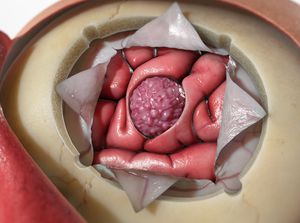Surgery for Intracranial Meningiomas
|
A meningioma is a brain tumour that grows from the protective coverings of the brain, known as the meninges. These thin layers of protective tissue surround your brain and spinal cord. Most meningiomas are not cancerous (benign) and usually grow slowly, however, can cause problems by pressing on the adjacent brain.
Options for treating meningiomas generally involve one or more of the following options: 1. Observation with serial MRI scanning (if the tumour is small and asymptomatic) 2. Surgery to remove the tumour 3. Radiotherapy This page focuses on surgery to remove a meningioma. For more general information about meningiomas click here. Surgery to remove a meningioma generally involves a procedure called a craniotomy. Given that most meningiomas are benign tumours, the goal of surgery is to safely remove as much tumour as possible, without harming the surrounding brain or nerves. |
 |
A craniotomy is a neurosurgical procedure which creates an opening through the skull to the brain, for removal of a meningioma or other brain lesion. This is a tumour in your meninges. performed under general anaesthesia,
The surgery usually requires several hours to complete, depending on the location and size of the meningioma. The goal of surgery is to safely remove the tumour from the surrounding brain tissue. For more information about craniotomy to remove a meningioma watch the video below.
The surgery usually requires several hours to complete, depending on the location and size of the meningioma. The goal of surgery is to safely remove the tumour from the surrounding brain tissue. For more information about craniotomy to remove a meningioma watch the video below.
Risks of Craniotomy for Removal of Meningioma
Most meningiomas are benign tumours that can be safely removed from the surrounding brain tissue and nerves without any serious complications. As they are usually benign tumours, if removal is likely to cause harm, it is often safer to leave some tumour behind at surgery. Like any surgical procedure there are risks associated with the anaesthetic and the procedure itself.
Risks of Anaesthesia
Risks of anaesthesia will be discussed with you by your anaesthetist prior to surgery. It is important that you inform us of your correct age and any past medical problems, as this can influence the risk of anaesthesia. Risks include:
- Heart problems, such as heart attack (AMI) or arrhythmia
- Lung problems, such as infection (pneumonia) or blood clots
- Urinary tract infection
- Deep Venous Thrombosis (DVT)
- Eye or visual problems
- Pressure wounds
- Stroke
- Small risk of significant life-threatening event
General Risks of Craniotomy
Although surgery for meningiomas is generally safe, there are some risks whenever performing a craniotomy. These include:
- Infection 1-2%
- Seizures which can require taking medication. Rarely this can lead to epilepsy requiring longterm medication.
- Bleeding. This can occur at the time of surgery and may necessitate a blood transfusion. It can also occur at some time after surgery. The bleeding may be present in the brain or adjacent to it. Sometimes another operation is required to drain the bloodclot and stop the bleeding.
- Stroke
- Brain fluid leak (CSF leak)
- Small risk of significant neurological injury causing paralysis, coma or death.
Specific Risks of Craniotomy for Meningioma
The specific risks depend on the size and location of the meningioma, whether or not you have had previous surgery, and other factors. The specific risks will be discussed in detail prior to your surgery but may include:
- Loss of smell
- Damage nerves in the brain (cranial nerves) resulting in facial numbness, weakness of the face, loss of vision or double vision.
- Weakness in your arms and legs
- Numbness in the limbs
- Speech disturbance or paralysis (stroke like symptoms).
- Cognitive impairment and memory problems
- Incomplete removal
- Recurrence of the tumour
- Requirement for further treatment with radiotherapy
